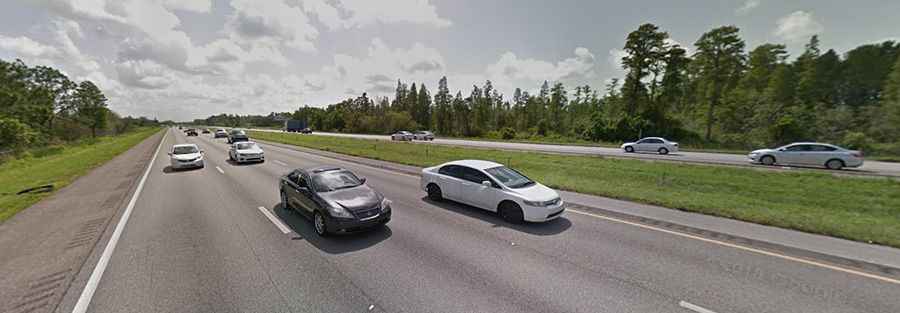Driving the dangerous Interstate 4 (I-4) in Florida
If you are a big fan of both dangerous roads and US interstates, you might want to take a trip to Central Florida and try your hand at Interstate 4 (I-4). There isn't another highway quite like I-4 anywhere else in the country. I-4 has earned the designation as the nation's most dangerous interstate for several years running.

How long is Interstate 4 (I-4) in Florida?
I-4 is a stretch of interstate that runs from I-95 in Daytona Beach clear across the state to Tampa. Despite being only 212km (132 miles) in length, the highway has claimed hundreds of lives in recent years. Data from the National Highway Traffic Safety Administration (NHTSA) makes it clear that this is a highway you absolutely must be careful about.
The two most dangerous sections are found in the greater Orlando area and the last few miles before I-4 meets I-275 in downtown Tampa. The many miles between are no picnic either. Perhaps you'd like to know why?
Tourists and Snowbirds
Central Florida is arguably the most visited tourist destination in America. The region sees tens of millions of visitors every single year. That doesn't even account for all of the snowbirds who spend their winters in central Florida. It is that combination of tourists and snowbirds that creates one of the biggest problems on I-4.
The highway is already heavily travelled by local residents getting to and from work. As the only interstate running east to west, I-4 is also heavily trafficked by trucks of all shapes and sizes. Even without tourists and snowbirds, there is a lot of traffic on the road every single day. The tourists and snowbirds only make traffic worse.
The thing about tourists and snowbirds is that they are not necessarily confident about where they are going. That makes them extra cautious and more prone to making unexpected decisions. Panic can even set in when traffic is at its heaviest. It is a recipe for accidents if ever there was one.
Excessive Speed
It doesn't help that vast stretches of I-4 have a posted speed limit of 65 mph. This is not necessarily a bad thing in wide-open areas where urban traffic is limited. But such stretches are not the norm on I-4. Remember, the highway is only 132 miles long. There are only a few short stretches the do not pass through urban or suburban areas.
Posted speed limits are lower in and around Orlando and the outskirts of Tampa, but they are about as effective as speed bump kits at Daytona International Speedway. The problem is that locals don't mind going 65 or 70 mph because they are familiar with the highway. Visitors, not so much. What happens when a local travelling at a high rate of speed suddenly catches up to a tourist going 20 to 30 mph slower?
Inadequate Infrastructure
If unfamiliar drivers and excessive speed are not bad enough, adding to I-4's woes is Florida's inadequate infrastructure. The state's population is growing faster than infrastructure projects can keep up with. Moreover, state planners typically do a lousy job of dealing with traffic until years after land development has created and untenable situation. A good example is the I-4/Route 27 interchange in Davenport, Florida. This particular area has been under heavy development for the last several years with no end in sight. Still, there doesn't seem to be any kind of effort among state leaders to start working on traffic problems now. At peak, it can take up to 60 minutes to travel the 6 miles between Route 27 and the edge of Disney's property – just because there's so much traffic trying to enter the highway from three main arteries.
Meanwhile, developers keep building houses. Leaders in Davenport continue approving commercial projects in hopes of making the area a leader in logistics and freight moving. I-4 isn't keeping up and there aren't enough alternate routes to absorb the excess.
The Worst Times to Travel
There is no doubt that I-4 is a dangerous road. It is also not for the faint of heart. Under normal circumstances, the busiest times of the day are morning drive time and the afternoon hours between 3 and 7 PM. On weekends, heavy traffic can persist until 10 or 11 at night. January is the absolute worst time to be on I-4 around Orlando and Tampa. That is when you are dealing with college football games and a plethora of other big events that bring in tons of people from out- of-state. July, August, November, and December are no picnic either. They are the four busiest months for theme park tourism.
A Word of Advice
Anyone visiting from out of town would do well to avoid I-4 if at all possible. To that end, here is a word of advice: do not rely on GPS devices to get around. Use an old-fashioned map. Why? Because development is happening so fast in the Central Florida area that GPS devices are often unreliable. If you love taking your chances on the world's most dangerous roads, you might want to seek your next thrill on Central Florida's I-4. You haven't lived until you've driven its length during peak traffic times. If nothing else, a few hours on I-4 will put hair on your chest.